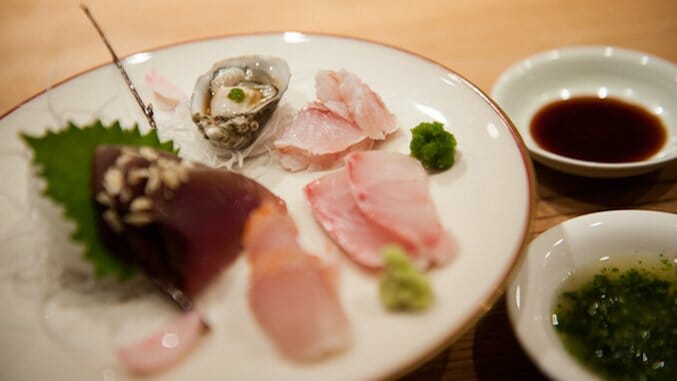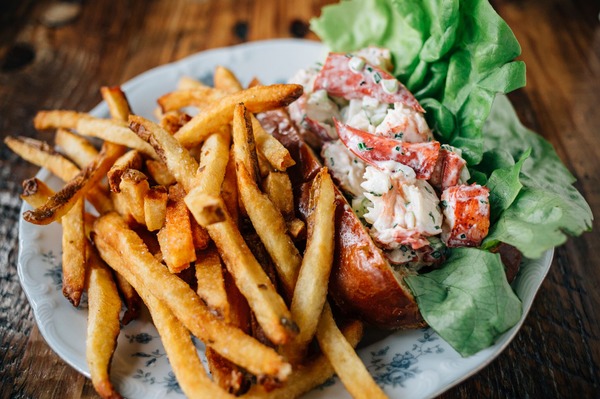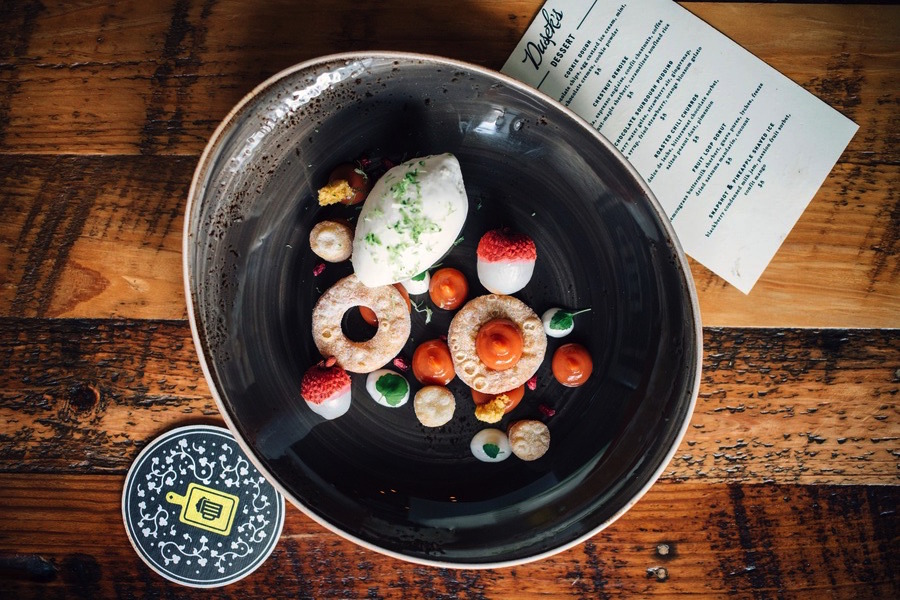
One star: A very good restaurant in its category
Two stars: Excellent cooking, worth a detour
Three stars: Exceptional cuisine, worth a special journey
Bruce Finkelman and Craig Golden are happy men. Their restaurant Dusek’s in Chicago won a Michelin star last year under the leadership of Chef Jared Wentworth, and in 2017 they’ll retain it. The damndest thing is that they serve a cheese-stuffed pretzel and a fun take on chicken and waffles. By all accounts it sounds like a high-class neighborhood bar with as big a passion for beer as food. Isn’t Michelin supposed to be about jackets and ties, and super-slick sommeliers? The times, they are certainly changing — and it’s great.
“Michelin’s goal is to pick out the best of each category of restaurants in each [major] city in the world,” said Bruce Finkleman, managing partner at 16 On Center, the company that owns Dusek’s. “As presenting food evolves, it is really amazing to see Michelin evolving with it as well.”
Bibendum. That’s the French name for the Michelin Man. The perpetually smiling, puft-staying mascot is one of the world’s oldest trademarks. For more than 100 years Bibendum has advertised tires. That’s him on the cover of the Michelin Guide too, cheerfully suggesting tremendous restaurants. But unlike his tires, the guide has only recently taken on the world.
 Photo courtesy of Dusek’s
Photo courtesy of Dusek’s
In 1900 the Michelin tire company to produce a road guide for the roughly 3,000 car owners in France. The guide’s primary remit was advancing the motor industry, hence selling more tires. The first edition contained maps, gas stations, servicing locations, and hotels and restaurants throughout France. Gradually, more guides were offered: first for a few locations in North Africa, and then for different countries in Europe.
The popularity of the restaurant section prompted Michelin to adapt. After the First World War they adopted the gold standard for the very best in their guides — the Michelin star. While there are other superb and influential organizations, like the The World’s 50 Best Restaurants and Zagat, Michelin remains one of the most recognizable. Replete with a team of covert inspectors and armed with a three-star rating tier for the elite, the company continued with a formula that had the ability to crush or charm chefs and restaurants alike. But what did that mean?
 Photo courtesy of Dusek’s
Photo courtesy of Dusek’s
Well, for the longest time, the Michelin guide was… francocentric. Haute cuisine, and specifically food prepared in the French method, seemed to be the underlying criteria for stars. Though European countries with strong culinary identities like Italy, Spain and Germany got guides of their own in the middle of the last century, Michelin could never seem to take seriously anything not “high cuisine” in style.
A whole culture of Michelin stars developed — training in starred kitchens became prerequisite, imbuing chefs with the proper skill set and superlative understanding. And not only did your food have to be perfect – the service and space had to match. It lent the guide an air of superiority that was outright exclusive to the masses. No, restaurants with Michelin stars were simply not for riff-raff.
The exalted brand not only excluded many of those whose wheels were clad in its own rubber, but also skewed heavily towards French-influenced European food. Michelin has had to adapt in the last 20 years to become globally relevant. It started with restaurants outside the ‘norm’ gaining attention, like Tamarind in London. In 2001 it became the first Indian restaurant to be awarded a Michelin star.
The whole paradigm changed in 2006 with the first New York edition of the Michelin Guide. It was swiftly followed by guides in Chicago, San Francisco, Hong Kong, Singapore, Tokyo and most recently, Washington D.C. To become even more accessible, Michelin introduced the Bib Gourmand classification, judging restaurants by a new yardstick: value for money. This year, two street-food stalls in Singapore were awarded stars. Twenty years ago the purists would have laughed.
Chef Toshio Tomita, who runs his Japanese-fusion restaurant Cagen in New York, won a star in the 2016 and 2017 guides. His value for the recognition is independent of Michelin’s Eurocentric roots, and charmingly earnest: “I have no idea what criteria Michelin looks for in a restaurant in detail, but I did notice more and more different types — fusions — of restaurants were getting listed in the guide in the past few years.”
 Photo by Nancy Borowick
Photo by Nancy Borowick
After expressing delight at the pleasant and helpful surprise of his star, Chef Tomita concluded, “The culinary world is consistently changing, so it would practically be impossible for Michelin to stick to a purely traditional or classic way of rating restaurants.” His comments suggest that there is ample room for the European, the international and the non-conformist.
Now, let’s backtrack a bit. Only great restaurants with high standards make it into the guide — New York contained more than 500. Only 39 of these were awarded stars in the 2006 edition, and only four of those had three stars. But even though many of the restaurants were “classic” many were not. The goal posts were not moved; the field began to change, particularly for restaurants in countries where the light of European gastronomy shined dimmer.
“At our restaurants we pride ourselves in providing a fine dining experience with the level of food and service that you would usually find in a more formal setting. We are really excited to see Michelin expanding their view to recognize deserving restaurants that meet these same hallmarks and their ability to serve inviting, high-quality food, in a more accessible and contemporary location,” Craig Golden, President of Blue Star Properties and Dusek’s co-owner said of the shift.
Whether or not Michelin’s new encompassing strategy is designed purely to push its brand in other countries is open to debate. Whatever the motivations, the result is important. Michelin have broken free from strict doctrine, honoring the true essence of outstanding food. And they seem to have done it without taking anything away from ‘classic’ restaurants. Dusek’s and Cagen embody this new way of thinking — let’s hope they enjoy stars for many years to come.
Benjamin Kay lives on the Suffolk Coast of England with his two bearded dragons, cats and long-suffering wife. He can be found haggling for fresh seafood or infrequently updating twitter @benjaminjkay